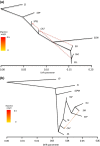Genotyping by sequencing reveals contrasting patterns of population structure, ecologically mediated divergence, and long-distance dispersal in North American palms
- PMID: 29938100
- PMCID: PMC6010798
- DOI: 10.1002/ece3.4125
Genotyping by sequencing reveals contrasting patterns of population structure, ecologically mediated divergence, and long-distance dispersal in North American palms
Abstract
Comparative studies can provide powerful insights into processes that affect population divergence and thereby help to elucidate the mechanisms by which contemporary populations may respond to environmental change. Furthermore, approaches such as genotyping by sequencing (GBS) provide unprecedented power for resolving genetic differences among species and populations. We therefore used GBS to provide a genomewide perspective on the comparative population structure of two palm genera, Washingtonia and Brahea, on the Baja California peninsula, a region of high landscape and ecological complexity. First, we used phylogenetic analysis to address taxonomic uncertainties among five currently recognized species. We resolved three main clades, the first corresponding to W. robusta and W. filifera, the second to B. brandegeei and B. armata, and the third to B. edulis from Guadalupe Island. Focusing on the first two clades, we then delved deeper by investigating the underlying population structure. Striking differences were found, with GBS uncovering four distinct Washingtonia populations and identifying a suite of loci associated with temperature, consistent with ecologically mediated divergence. By contrast, individual mountain ranges could be resolved in Brahea and few loci were associated with environmental variables, implying a more prominent role of neutral divergence. Finally, evidence was found for long-distance dispersal events in Washingtonia but not Brahea, in line with knowledge of the dispersal mechanisms of these palms including the possibility of human-mediated dispersal. Overall, our study demonstrates the power of GBS together with a comparative approach to elucidate markedly different patterns of genomewide divergence mediated by multiple effectors.
Keywords: Arecaceae; Baja California peninsula; genotyping by sequencing (GBS); human‐mediated dispersal; single nucleotide polymorphism (SNP).
Figures






Similar articles
-
Geographic isolation and long-distance gene flow influence the genetic structure of the blue fan palm Brahea armata (Arecaceae).J Plant Res. 2023 May;136(3):277-290. doi: 10.1007/s10265-023-01445-9. Epub 2023 Mar 11. J Plant Res. 2023. PMID: 36905462
-
Molecular genetic analysis of two native desert palm genera, Washingtonia and Brahea, from the Baja California Peninsula and Guadalupe Island.Ecol Evol. 2017 May 30;7(13):4919-4935. doi: 10.1002/ece3.3036. eCollection 2017 Jul. Ecol Evol. 2017. PMID: 28690819 Free PMC article.
-
LOW GENIC DIFFERENTIATION AMONG ISOLATED POPULATIONS OF THE CALIFORNIA FAN PALM (WASHINGTONIA FILIFERA).Evolution. 1986 Mar;40(2):315-322. doi: 10.1111/j.1558-5646.1986.tb00473.x. Evolution. 1986. PMID: 28556029
-
Phylogeography of endemic Xantus' hummingbird (Hylocharis xantusii) shows a different history of vicariance in the Baja California Peninsula.Mol Phylogenet Evol. 2016 Sep;102:265-77. doi: 10.1016/j.ympev.2016.05.039. Epub 2016 May 31. Mol Phylogenet Evol. 2016. PMID: 27261252 Review.
-
The mutualism-antagonism continuum in Neotropical palm-frugivore interactions: from interaction outcomes to ecosystem dynamics.Biol Rev Camb Philos Soc. 2022 Apr;97(2):527-553. doi: 10.1111/brv.12809. Epub 2021 Nov 1. Biol Rev Camb Philos Soc. 2022. PMID: 34725900 Free PMC article. Review.
Cited by
-
Genotyping-by-sequencing informs conservation of Andean palms sources of non-timber forest products.Evol Appl. 2024 Jul 31;17(8):e13765. doi: 10.1111/eva.13765. eCollection 2024 Aug. Evol Appl. 2024. PMID: 39091352 Free PMC article.
-
Geographic isolation and long-distance gene flow influence the genetic structure of the blue fan palm Brahea armata (Arecaceae).J Plant Res. 2023 May;136(3):277-290. doi: 10.1007/s10265-023-01445-9. Epub 2023 Mar 11. J Plant Res. 2023. PMID: 36905462
-
Genetic Diversity and Population Structure of Doum Palm (Hyphaene compressa) Using Genotyping by Sequencing.Front Genet. 2022 Feb 4;13:762202. doi: 10.3389/fgene.2022.762202. eCollection 2022. Front Genet. 2022. PMID: 35186022 Free PMC article.
-
Population genomics and distribution modeling revealed the history and suggested a possible future of the endemic Agave aurea (Asparagaceae) complex in the Baja California Peninsula.Ecol Evol. 2024 Jul 24;14(7):e70027. doi: 10.1002/ece3.70027. eCollection 2024 Jul. Ecol Evol. 2024. PMID: 39050658 Free PMC article.
-
RAD sequencing sheds new light on the genetic structure and local adaptation of European scallops and resolves their demographic histories.Sci Rep. 2019 May 15;9(1):7455. doi: 10.1038/s41598-019-43939-4. Sci Rep. 2019. PMID: 31092869 Free PMC article.
References
-
- Aleixandre, P. , Hernandez‐Montoya, J. , & Mila, B. (2013). Speciation on Oceanic Islands: Rapid adaptive divergence vs. cryptic speciation in a Guadalupe Island Songbird (Aves: Junco). PLoS ONE, 8, e63242 https://doi.org/10.1371/journal.pone.0063242 - DOI - PMC - PubMed
-
- Anderson, J. T. , Willis, J. H. , & Mitchell‐Olds, T. (2011). Evolutionary genetics of plant adaptation. Trends in Genetics, 27, 258–266. https://doi.org/10.1016/j.tig.2011.04.001 - DOI - PMC - PubMed
-
- Andrews, K. R. , Good, J. M. , Miller, M. R. , Luikart, G. , & Hohenlohe, P. A. (2016). Harnessing the power of RADseq for ecological and evolutionary genomics. Nature Reviews Genetics, 17, 81–92. https://doi.org/10.1038/nrg.2015.28 - DOI - PMC - PubMed
-
- Aschmann, H. (1957). The introduction of the date palm to Baja California. Economic Botany, 11, 174–177. https://doi.org/10.1007/BF02985306 - DOI
-
- Avise, J. C. (2000). Phylogeography: The history and formation of species. Cambridge, UK: Harvard University Press.
Associated data
LinkOut - more resources
Full Text Sources
Other Literature Sources

